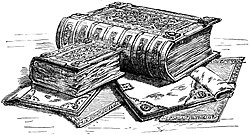Search results
Appearance
There is a page named "Boldon Book" on Wikipedia
- The Boldon Book (also known as the Boldon Buke) contains the results of a survey of the bishopric of Durham that was completed on the orders of Hugh du...3 KB (370 words) - 11:48, 4 April 2024
- The Boldons is an area made up of the three villages of East Boldon, West Boldon and Boldon Colliery in South Tyneside, in the county of Tyne and Wear...12 KB (1,299 words) - 21:09, 26 June 2025
- a variety of shops. The first written instance of Whitburn is in the Boldon Book of 1183, where the village is recorded as Whitberne. This name may refer...41 KB (3,749 words) - 21:34, 25 May 2025
- County Durham district, in the ceremonial county of Durham, England. The Boldon Book mentions a mine in Coundon in the twelfth century. In 2001 it had a population...5 KB (335 words) - 18:38, 13 June 2025
- existed on a small-scale as early as 1183 when it is mentioned in the Boldon Book, it was limited by the lack of an easy way to transport coal away from...92 KB (9,103 words) - 02:38, 7 May 2025
- population of the village as taken at the 2011 Census was 116. Listed in the Boldon Book (1183), “Robert Corbet held Hunstanworth by forest service, as is expressed...3 KB (392 words) - 11:33, 11 February 2025
- century. The Boldon Buke (Book) – a survey of the bishopric of Durham a century later than Domesday Photographic facsimiles of Domesday Book, for each county...46 KB (5,459 words) - 20:00, 23 May 2025
- administrative and ceremonial purposes until the Local Government Act 1972. Boldon Book (1183 or 1184) is a polyptichum for the Bishopric of Durham. Until the...52 KB (5,817 words) - 13:16, 11 February 2025
- of the Pennines and the surrounding countryside for miles around. The Boldon Book of 1183 records Medomsley as Medomesley. The Vita S Godrici, written...10 KB (998 words) - 13:46, 28 April 2025
- Woodstone Village. The earliest mention of the town's name is in the Boldon Book in 1183 as 'Hoctona'. An English transcription states: In Houghton are...11 KB (1,188 words) - 18:18, 25 January 2025
- It is situated to the south west of Consett. First documented in the Boldon Book as Heleie, “Alain de Chilton, holds Heley, as is contained in his charter...5 KB (602 words) - 03:57, 15 May 2025
- In 1931 the parish had a population of 6395. First documented in the Boldon Book as Ivestan. The village is also listed in Bishop Hatfield’s survey (1381)...6 KB (770 words) - 23:49, 6 June 2025
- the South Tyneside ward of Cleadon and East Boldon was 8,427. Nearby population centres include East Boldon, Whitburn, and Jarrow. The village is located...50 KB (4,929 words) - 12:50, 1 June 2025
- it was known as New Penshaw. The earliest record of Penshaw is in the Boldon Book of 1183, where it is described as being leased by William Basset from...92 KB (9,947 words) - 10:26, 6 July 2025
- Exeter Domesday Book)Censualis, vocati Domesday Book, Additamenta ex Codic. Antiquiss. Exon Domesday; Inquisitio Eliensis; Liber Winton; Boldon Book. London: Record Commission...7 KB (531 words) - 11:28, 24 May 2025
- Eliensis and the Boldon Book. The circulation of Farley's edition was too limited to expand significantly public access to the Domesday Book. That was to...21 KB (2,775 words) - 08:33, 27 February 2025
- census of 7323. The first mention of Newton occurs about 1183, in the Boldon Book, a record of the estates of the Bishop of Durham, Hugh le Puiset. Newton...7 KB (1,158 words) - 12:22, 19 August 2024
- finished, the results were entered into a register that became known as the Boldon Book. Hugh also fought a long-running disagreement with his own cathedral...24 KB (2,880 words) - 12:56, 25 May 2025
- areas that have remained free from human interference. Listed in the Boldon Book (1183).—“The Prior holds Muglyngwyc, as is expressed in his charter,...8 KB (823 words) - 00:15, 5 February 2025
- The County Palatine of Durham, 1900, p. 296, footnotes 3, 4, and 5. Boldon Book, App, i to xiii. Although the Sheriff compounded for Danegeld, it was...41 KB (4,232 words) - 15:15, 7 June 2025
- Wikipedia has an article on: Boldon Book Wikipedia Boldon Buke From Middle English Boldon Buke, from Boldon + buke. the Boldon Book The record of a Norman
- was for many years the occasional residence of the bishops of Durham. Boldon Book, dated 1183, contains the first mention of Darlington as a borough,
- enter the control codes */ CSI='9b'x /* control sequence introducer */ boldOn=CSI'1m' boldOff=CSI'22m' IF OPEN("Env", "Env:File", "R") THEN DO filename
















